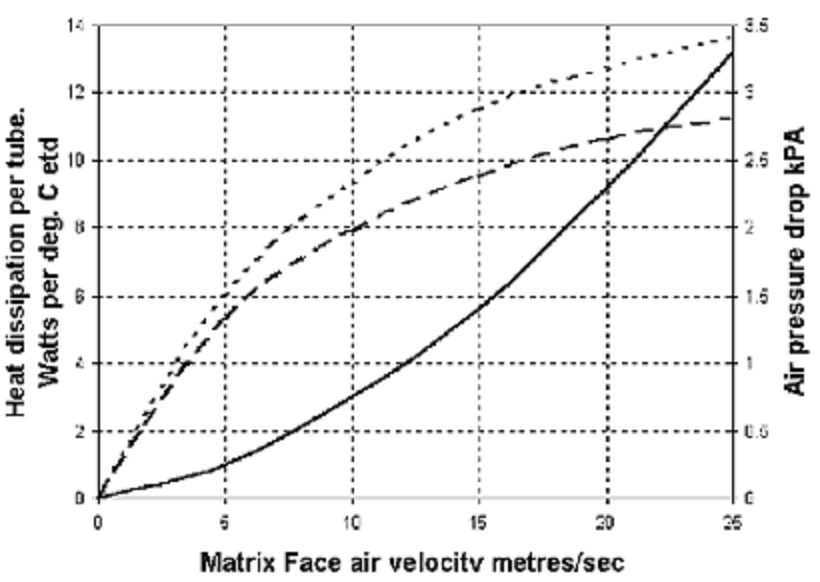|
|
That would have been my next question,
too.
It seems to me that there will always be curves showing
improvement, then decreasing improvement (diminishing returns).
But in the real world, the 'targets' are always moving. Delta-t
between mediums (water-air, oil-air) will change as source temps
change, and as air temps change, so the curves are always moving
in relation to each other. Then there's the issue of aero drag due
to air speed through the heat exchanger, and fluid drag of the
liquid through the HE, and power losses due to both. And even if
we accept some really low airspeed as optimum (ex: 11.2 mph in
that Mocal example), is it reasonable to think we can slow 180 mph
freestream air to 11 mph? And all the above changes with tube size
and fin spacing.
The earlier statement that I can't come to grips with is that the
air can move too fast to absorb the heat. Yes, there's a point of
diminishing returns (where the delta-t gets so small that
efficiency drops), and a point where aero drag gets excessive, but
I can't grasp the idea of the air moving too fast for the heat to
catch it. ;-)
Charlie
On 7/21/2021 10:11 AM, Finn Lassen finn.lassen@verizon.net wrote:
Seems what we're missing is a curve
that's the product of these curves.
In other words some kind of bell or parabolic curve with top
where you have max cooling/drag.
Obviously you can push fluid (and air) through a radiator at a
furious rate, but the drag will go up.
So for both fluid and air rates there must be an optimum spot.
Finn
On 7/21/2021 8:42 AM, Stephen Izett stephen.izett@gmail.com
wrote:
This graph from Mocal might be helpful. It's for their oil
coolers but the trends may be transferable to water exchangers.
The solid line is Pressure Drop.
The two dotted lines tell the story of two
different oil flow rates/tube.
| m/sec |
5 |
10 |
15 |
20 |
25 |
| kmh |
18 |
36 |
54 |
72 |
90 |
| mph |
11.2 |
22.4 |
33.6 |
44.8 |
55.9 |
Increasing the air flow 5 fold from 11 to 56 mph
only increases the heat transfer:
2 fold with an oil flow of 0.02 L/sec/ tube and
2.3 fold by doubling the oil flow rate per tube to 0.04
L/sec/tube
While pressure drop increased 13 fold.
So, diminishing returns from increasing airflow or
fluid flow.
Steve Izett
Charlie,
No, no
reference, just what I have read and also talking
to Rad manufacturers such as BWR in Brisbane. You
can check it out by passing your hand through a
naked flame. Quickly and there is no heat
transfer. Pass slowly and you will see what the
argument is. As I said the truth is there
somewhere and as Lyn so aptly puts it “I could
well be wrong”..
Neil.
Hi
Neil,
Do you have a reference for that? Slowing a medium
down so it has time to absorb the heat seems to
conflict with physics as I've been led to
understand it.
Charlie
On 7/20/2021 5:01 PM, 12348ung@gmail.com wrote:
Charlie,
Much
wisdom out there, you just have to find the
truth! Max cooling is apparently 30 MPH, so
Any faster and it does not pick up heat before
going past. Look at big trucks, that grill is
not only for looks, they slow the air to get max
cooling. If too slow they have a quite large
fan that kicks in to drag air through at 30 MPH
not 100!
As you
say, what do I know – I have seen too many that
do not work – without any degree.
Neil.
Subject: Inlet cooling article
I
remember the Laboda article about enlarging their
cooling inlets, but not many of the details.
This:
The plenum
receives air through two circular air intake
ducts behind the propeller and squeezes it,
Bernoulli-style, so that the air accelerates
across the cylinders and between their fins,
carrying the heat back, down and out an outflow
"gate" at the back and bottom of the engine
area, forward of the firewall.
Is contrary to everything I've ever read about
cooling efficiently. Faster relative flow will
always have higher drag, all else being equal.
Accelerating the air even faster than freestream
just sounds crazy. My understanding is that
there's a balancing act between having the room in
an a/c to 'recover' (increase) differential
pressure across the heat exchanger (engine fins,
in this case), and causing too much drag from the
air going through the fins too fast (there's
aerodynamic drag in the heat exchanger, just like
over the a/c itself). It's surprising to me that
James made the plenum the way he did. The rest
sounds like putting bandaids on stuff. The
next-to-last image, of the final inlet, shows what
appears to be a *much* smaller plenum inlet than
the cowl ring in front of it, and a rather sharp
edged lip where the plenum starts. It looks like
the air would accelerate until it hits that sharp
lip, and immediately go turbulent, which will kill
any pressure recovery and actually slow flow into
the cylinder fins.
Most Lyc plenums I've seen (even the ones James
made for the 4 cyl engines) have significant
volume above the cylinders with smoothly expanding
ducts feeding the plenum. That allows the air to
slow in an organized fashion, which increases
*pressure*, which is what actually makes the air
move through the fins.
But what do I know; I have an Economics degree....
Charlie

Screen Shot 2021-07-21 at 7.58.40 pm.png
|
|